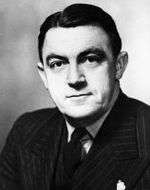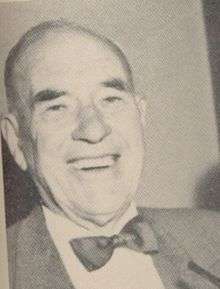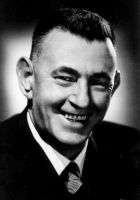Victorian state election, 1950
| | |||||||||||||||||||||||||||||||||||||||||||||||||||||||||||
| |||||||||||||||||||||||||||||||||||||||||||||||||||||||||||
| |||||||||||||||||||||||||||||||||||||||||||||||||||||||||||
| |||||||||||||||||||||||||||||||||||||||||||||||||||||||||||
The 1950 Victorian state election was held in the Australian state of Victoria on Saturday 13 May 1950 to elect 65 members of the state's Legislative Assembly.
Background
The previous state election in May 1947 had resulted in the Liberal–Country coalition led by Thomas Hollway winning by a substantial majority. In late 1948, Country leader and Deputy Premier John McDonald criticised Hollway over his "lack of strength" in dealing with a long-running transport strike, and his conciliatory negotiations with the transport unions.[1] Hollway responded by sacking McDonald as his deputy and dissolving the coalition. The Country Party became the official opposition (with three seats more than Labor in the assembly). Hollway formed a minority Liberal government, convincing four Country Party assembly members (Guye, Hedditch, Hipworth and Mibus) to defect to his party, which he provocatively renamed the Liberal and Country Party.[2]
Despite lacking a majority, Hollway's government survived for nearly a year due to the support of two Country members (Bennett and Hyland) and the casting vote of the Speaker, Sir Thomas Maltby, in vital divisions. In February 1950, the LCP voted to expel two members of the parliamentary party—Fred Edmunds and John Lechte—for disloyalty, reducing the government's members to 30.[3] On 12 April, the Governor of Victoria, Sir Dallas Brooks, summoned McDonald and Labor leader John Cain to gain their assurance that they would not form a joint ministry. Hollway was then summoned, and agreeing that the house had become unworkable and that there was no chance of the LCP and Country Party reconciling, was granted a dissolution of the assembly.[1]
Labor had lost the seat of Geelong to the Liberals in a 1948 by-election following the death of Fanny Brownbill.[4]
Former Premier and member for Korong, Sir Albert Dunstan, died suddenly on 14 April—the day after the dissolution of the Legislative Assembly and the issue of the election writs. Due to the proximity of the general election, no by-election was held for his seat.[5]
Results
Legislative Assembly
|
Victorian state election, 13 May 1950[6][7] | ||||||
|---|---|---|---|---|---|---|
| Enrolled voters | 1,294,159 | |||||
| Votes cast | 1,221,734 | Turnout | 94.40 | +0.96 | ||
| Informal votes | 13,901 | Informal | 1.14 | −0.19 | ||
| Summary of votes by party | ||||||
| Party | Primary votes | % | Swing | Seats | Change | |
| Labor | 546,978 | 45.29 | +4.42 | 24 | +8 | |
| Liberal and Country | 491,448 | 40.69 | +3.53 | 27 | −3 | |
| Country | 128,537 | 10.64 | −4.28 | 13 | −3 | |
| Communist | 6,308 | 0.52 | +0.39 | 0 | ±0 | |
| Independent | 34,562 | 2.86 | −4.06 | 1 | ±0 | |
| Total | 1,207,833 | 65 | ||||
See also
References
- 1 2 "VICTORIAN HOUSE DISSOLVED ELECTION IN MAY.". The Canberra Times. ACT: National Library of Australia. 13 April 1950. p. 1. Retrieved 18 May 2012.
- ↑ "NO CHANGE IN VICTORIAN CABINET.". The Mercury. Hobart, Tas.: National Library of Australia. 24 March 1949. p. 14. Retrieved 18 May 2012.
- ↑ "EARLY ELECTION IS TIPPED IN VIC.". The Examiner. Launceston, Tas.: National Library of Australia. 15 February 1950. p. 5. Retrieved 18 May 2012.
- ↑ "GEELONG SEAT.". The West Australian. Perth: National Library of Australia. 16 November 1948. p. 10 Edition: 2nd EDITION. Retrieved 18 May 2012.
- ↑ "Sir Albert Dunstans career 'SHREWDEST MAN IN STATE POLITICS' IS DEAD.". The Argus. Melbourne: National Library of Australia. 15 April 1950. p. 5. Retrieved 18 May 2012.
- ↑ Election held on 13 May 1950, Australian Politics and Elections Database (University of Western Australia).
- ↑ Colin A Hughes, A Handbook of Australian Government and Politics 1890-1964, Canberra: Australian National University Press, 1968 (ISBN 0708102700).


